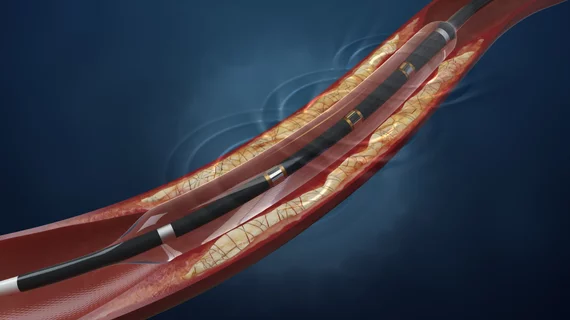Late-breaking study examines IVL’s safety and effectiveness among real-life PAD patients
Intravascular lithotripsy (IVL) is associated with consistent improvements in patients who present with complex, heavily calcified peripheral artery disease (PAD), according to a late-breaking clinical trial presented at the VIVA Foundation’s VIVA22 conference in Las Vegas.
Researchers behind the Disrupt PAD III observational study (OS) tracked data from nearly 1,400 real-world PAD patients with moderate or severe calcification. All patients were treated with the IVL technology developed and marketed by Shockwave Medical from November 2017 to June 2021 at one of 30 different facilities.
IVL was linked to a final residual diameter of 24% and a limited number of procedural complications. Final dissections were seen in 0.7% of patients, for instance, and perforations were seen in 0.2% of patients. No cases of embolization, thrombus formation, no reflow or abrupt closure were reported.
“These consistent results in a ‘real-world’ population, combined with the recent long-term outcomes from the Disrupt PAD III RCT, reinforce the positioning of IVL as a reliable, potential first-line therapy for the treatment of large and diverse patient populations with calcified PAD,” presenter Ehrin J. Armstrong, MD, medical director of the Adventist Heart and Vascular Institute in St. Helena, California, said in a prepared statement from Shockwave Medical. “The significant amount of data on IVL continue to show both consistent efficacy and safety across the most challenging lesions, various peripheral vessel beds, and even in the most complex, high-risk patients.”
VIVA22 in Las Vegas
Armstrong’s IVL presentation was part of the first round of late-breaking clinical trials presented at VIVA22. More information on the other presentations that took place during that first round is available here. Topics included drug-coated balloons vs. bare-metal stents for femoropopliteal lesions and the safety and effectiveness of the DETOUR system by Endologix for treating femoropopliteal disease. A second and third round of late-breaking clinical trials were also shared with attendees.
Additional details about VIVA22 are available on the VIVA Foundation’s website. The conference lasts until Thursday, Nov. 3.

